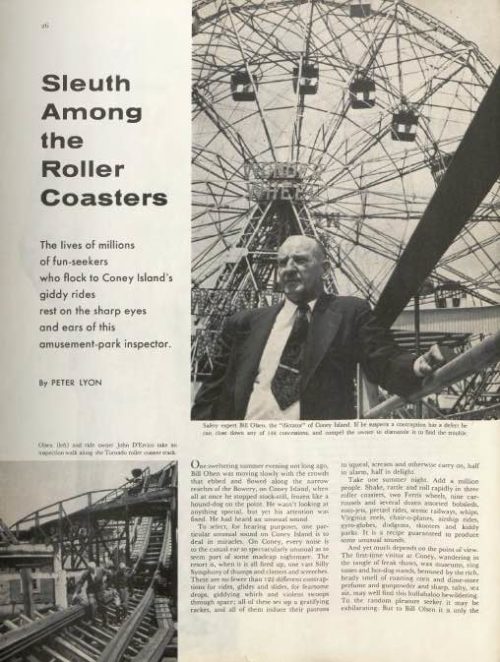Safety Second: Who Regulates Thrill Rides?
What is the price of excitement? Hundreds of millions of thrill ride attendees each year assume it’s the cost of a ticket, but some end up paying with a trip to the emergency room — or worse. Most people figure amusement rides are safe, but the safety regulations are fuzzy.
The United States boasts the tallest thrill rides in the world, and their namesakes suggest ferocity and danger: Fury, Intimidator, Lightning Rod. The appeal of amusement park rides is a feeling of peril — see the Post’s “When Science Takes You on a Ride” — but is there actually a risk?
According to the International Association of Amusement Parks and Attractions (IAAPA), the risk of “being seriously injured on a fixed-site ride at a U.S. amusement park is 1 in 16,000,000,” while the odds of being struck by lightning in the U.S. are 1 in 775,000.
Of course, the numbers are different for mobile rides — the ones found at carnivals and fairs. The U.S. Consumer Product Safety Commission estimates that over 30,000 emergency-room visits in 2016 were a result of thrill ride injuries overall. A recent malfunction on a ride at the Ohio state fair that killed one teenager and injured seven others prompted Governor John Kasich to call it “the worst tragedy in the history of the fair.” Last year three girls fell at least 30 feet from a Ferris wheel car at a county fair in Tennessee, and last week a crew rescued three people from a county fair bungee ride in California.
Some mobile rides have had systemic problems, like the Zipper. In 1977, the CPSC issued a warning to consumers and filed suit against the Chance Manufacturing Co. after four separate accidents on the Zipper left four people dead and two injured. All four incidents involved the locks on the doors of the carriages. This case helped to establish the CPSC as a regulator for carnival rides despite industry claims that a thrill ride is not a “consumer product.”
In 1981, a budget bill stripped federal oversight of fixed-site rides from the CPSC in a move known as the “roller coaster loophole.” This amendment left it up to individual states to set regulatory measures for permanent amusement parks and water parks. Some states have enacted strict regulations, while others remain without any.
In Kansas, amusement parks were left to perform their own inspections until a recent law established tighter rules on reporting accidents as well as a state-sanctioned inspector. This came after Kansas Rep. Scott Schwab’s son died on a water slide at Schlitterbahn Water Park in Kansas City in 2016. The ride, called Verrukt, was the tallest water slide in the world at the time. Immediately following the accident, reporting from several news outlets revealed other riders who had expressed previous concern over the inadequate seatbelt restraints. Schwab gave an emotional speech to the Kansas House in March in support of the law that would add government regulation.
Regulation for the amusement ride industry had been left up to individual companies in the past, when there wasn’t much of an industry. Coney Island employed its own safety inspector in the 1950s, as reported in The Saturday Evening Post’s 1957 article, “Sleuth Among the Roller Coasters.” That sleuth, Bill Olsen, was a Brooklyn elevator inspector charged with issuing licenses to individual ride owners and ensuring their compliance to a safety code seemingly composed of his own whims. The author followed Olsen around the fun park as he relied on his ears to detect any glitches in the park’s 122 rides. To be fair, Olsen’s record during his tenure was laudable: “During the 17 years that he has been the inspector of Coney Island’s rides there has been no major accident and only one minor accident.”
Thrill ride safety is not so conspicuous in the modern days of gargantuan coasters, however. Permanent amusement parks are not under jurisdiction of the CPSC, and they’ve been building taller and faster thrills in recent years. The concern with roller coasters that drop passengers 400 feet at more than 120 miles per hour is less about malfunction than it is about G-force.
Massachusetts Senator Edward Markey has cited the new monster roller coasters as one reason to allow CPSC oversight at fixed-site amusement parks. A recent ABC News story quoted Markey: “Some of these rides now reach speeds of 100 miles per hour and forces greater than astronauts are trained to endure on the space shuttle.” The senator contends that data on injuries from these rides would be more centralized with CPSC oversight.
The amusement park industry is, of course, opposed to any new federal regulations. The IAAPA maintains that “a majority of the injuries occur because the guest didn’t follow posted ride safety guidelines or rode with a pre-existing medical condition.”
Whatever the future of thrill ride regulation may be, Americans do not appear to be halting trips to theme parks. Six Flags Entertainment announced a seventh year of record attendance. For less intrepid riders, technological advancement can afford thrills that rely on illusion instead of linear induction motors. Virtual reality, even in cases of malfunction, is unlikely to cause injury — other than a little nausea.
Featured image by GOLFX on Shutterstock
